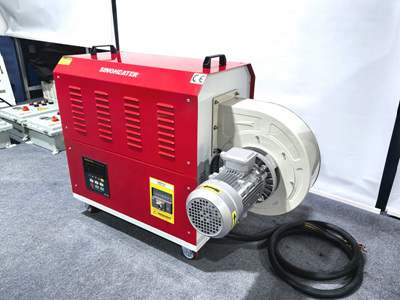In leather processing, softening leather with a hot air blower is a crucial process step, which directly affects the subsequent shaping, cutting and bonding quality. The following is an explanation from aspects such as the operating principle, parameter control, process flow and precautions:
First, the principle of softening leather by a hot air blower
Thermal conduction softening: Heat is transferred to the leather fibers through hot air, causing the hydrogen bonds between the molecular chains of collagen fibers to break, reducing the rigidity of the fibers and enhancing their plasticity.
Moisture activation effect: Trace amounts of moisture in leather vaporize at high temperatures, promoting fiber expansion and further reducing the hardness of the leather.
Scope of application: Natural leather (cowhide, sheepskin, etc.), recycled leather and some synthetic leather (temperature resistance needs to be verified).
Second, key parameter control
1. Temperature setting
Natural leather
Thin skin (0.8-1.2mm) : 60-70℃
Medium and thick leather (1.2-1.8mm) : 70-80℃
Thick skin (>1.8mm) : 80-90℃
Synthetic leather: It is recommended that the temperature be below 80℃ to prevent the surface coating from melting or deforming.
2. Wind speed and distance
Wind speed: Medium to low gear (2-3 levels), to prevent excessive wind speed from causing local overheating or drying and hardening of the leather surface.
Distance: Keep the hot air blower 10-15cm away from the leather surface to ensure even heat distribution.
3. Heating time
Thin skin: Heat each 10×10cm area for 10 to 15 seconds
Thick skin: Heat every 10×10cm area for 20-30 seconds
Dynamic monitoring: Determine the degree of softening by hand feel (the leather becomes soft and can be slightly bent) or by thermometer (approaching the set temperature).
Third, the operation process
1. Preparations
Leather pretreatment
Clean the surface dust and oil stains to avoid scorch marks when heated.
For dry leather, a small amount of water mist can be sprayed evenly (20cm from the surface) to enhance the softening effect.
Tool preparation:
Hot air blower (with temperature regulation function)
Infrared thermometer (real-time temperature monitoring)
Heat-insulating gloves, molding tools, shaping fixtures
2. Softening operation
Zonal heating
Divide the leather into small areas of 5×5cm or 10×10cm, and heat each area one by one to avoid omissions or repeated heating.
Uniform movement
The hot air blower moves slowly along an S-shaped trajectory to ensure that the heat covers the entire area.
For arc-shaped or edge parts, the heating time needs to be extended by 10% to 15%.
3. Shaping and setting
Instant shaping
Immediately after softening, place the leather in a mold or fixture and apply uniform pressure (if using a pressure plate or heavy object).
Shaping time: 5-10 minutes for thin skin and 15-20 minutes for thick skin.
Cooling and setting
Keep the pressure until the leather is completely cooled (about 30 minutes at room temperature), and avoid the rebound caused by suddenly removing the pressure.
Fourth, Precautions
Safe operation
Wear heat-insulating gloves to avoid scalding from high temperatures.
The operation area should be kept away from flammable materials and ensure good ventilation.
Leather protection
For dyed leather, it is necessary to test its heat resistance in advance to avoid fading.
Avoid hot air blowing directly onto the edges of the leather to prevent the fibers from breaking.
Equipment maintenance
Regularly clean the filter screen of the hot air blower to prevent dust from blocking the air duct.
Check the accuracy of the temperature sensor to ensure the reliability of the parameters.
Fifth, case application
Case 1: Leather covering of car seats
Process requirement: Soften 0.9mm thick cowhide and then cover it with the seat frame.
Operating parameters:
Temperature: 65℃
Wind speed: 2nd gear
Heating time: 12 seconds per area
Effect: The leather softens evenly, there are no wrinkles after covering, and the edges fit tightly.
Case 2: Shaping the corners of leather handbags
Process requirements: Bend and shape the edges and corners of 1.5mm thick sheepskin at 90°.
Operating parameters:
Temperature: 75℃
Wind speed: 3 gear
Heating time: 25 seconds per area
Effect: There are no cracks at the bending points, and a stable curvature is maintained after shaping.
Sixth, Summary
The core of softening leather with a hot air blower lies in “precise temperature control, uniform heating and immediate shaping”. By reasonably setting the temperature, wind speed and heating time, and combining with the standardized process flow, the efficiency and quality of leather processing can be significantly improved. During operation, it is necessary to closely monitor the condition of the leather and adjust the parameters in a timely manner to avoid defects caused by excessive heating or improper cooling.



